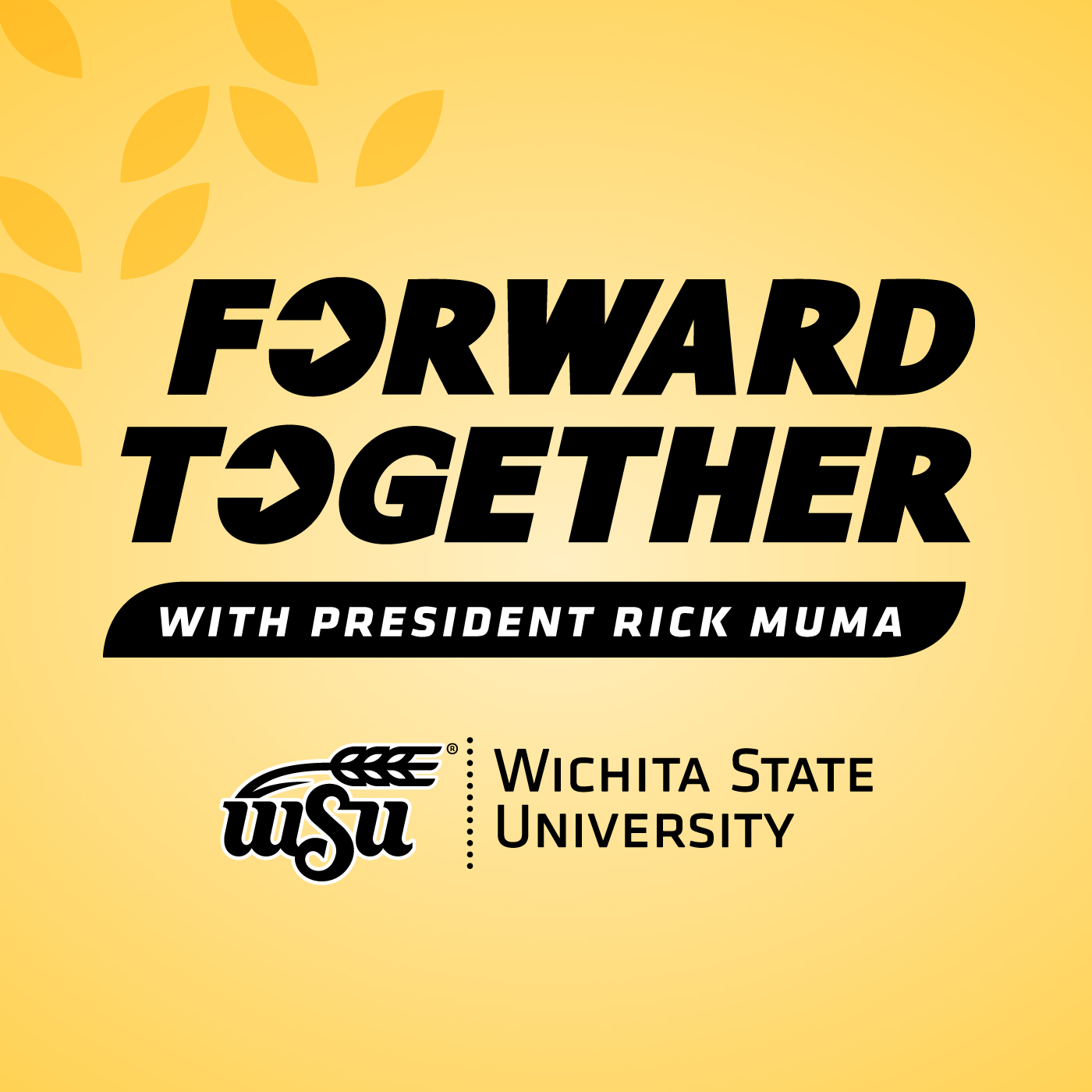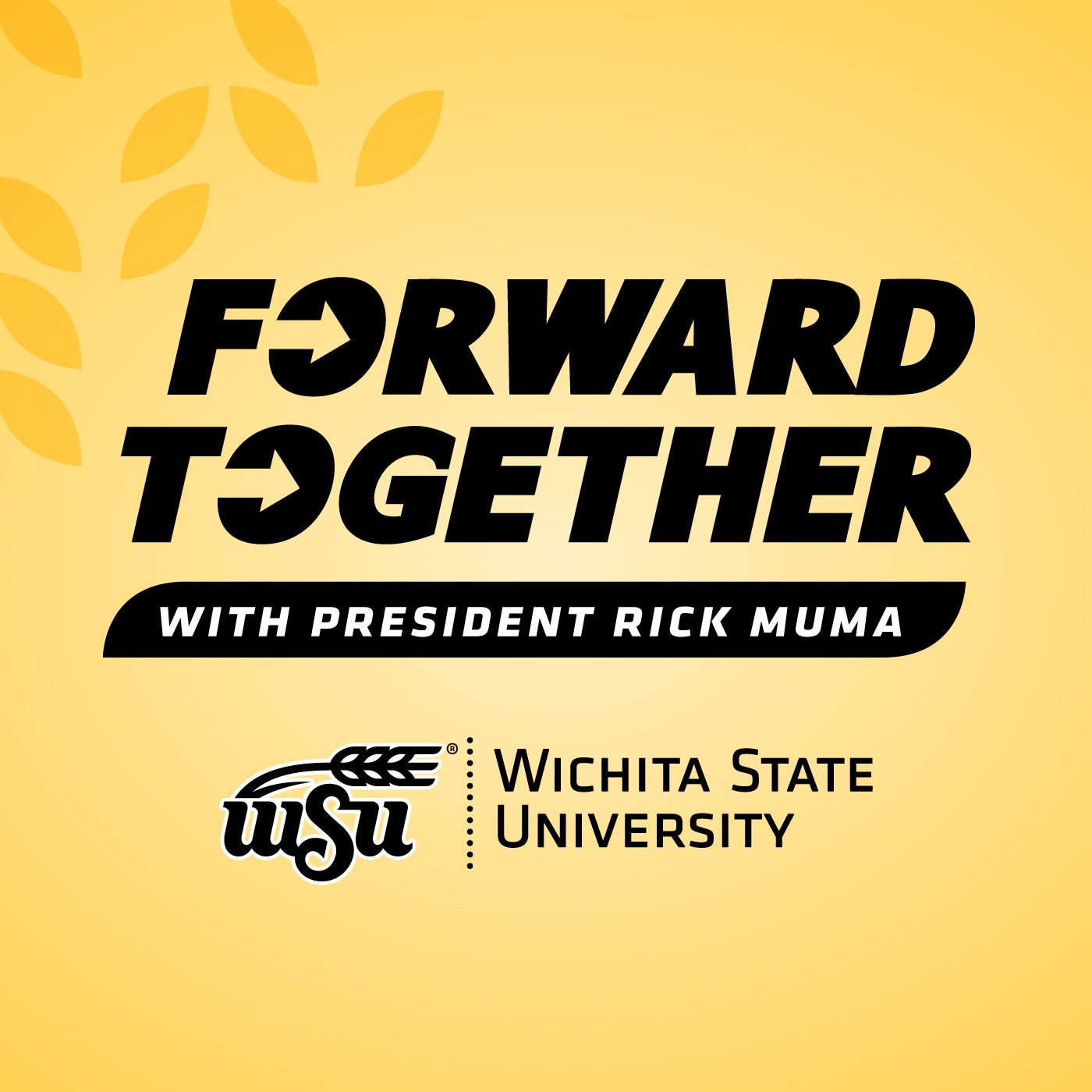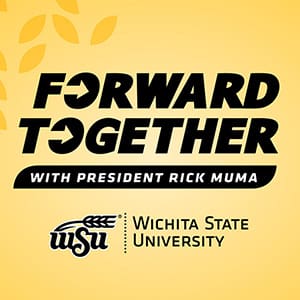Episode Transcript
Speaker 1 00:00:08 Hello Cha Nation. Welcome to the Forward Together Podcast. In today's episode, I'm gonna introduce you to some of our students who are doing remarkable things through their applied learning experiences and research. My first guest is Brittany Wachaki is working on her doctoral degree in aerospace engineering. Her research specialty is structures and solid mechanics with a particular interest in structural acoustics. And in 2021, she has awarded the prestigious National Science Foundation Graduate Research Fellowship. I Britney, how are you doing? I'm
Speaker 2 00:00:39 Doing great. How about
Speaker 1 00:00:40 You? So good to get to talk to you about your research, but before we do that, I want to talk about your experience at Wichita State. And you came here from St. Louis and I as an undergraduate student, and I wanted to know why you chose to come all the way to Wichita from St. Louis. Oh,
Speaker 2 00:00:56 Yeah. Uh, the process was very interesting. Um, and looking back I realized, uh, it might be very weird now to try. Um, so in high school, at a certain point I started receiving a ton of, you know, pamphlets and, and, and, um, advertisement to different universities. And I actually saved all of them. And so at a certain point I started sifting through and picked all the aerospace. Cause I knew I wanted to be in aerospace engineering out. And then I looked up, uh, a like top 50 aerospace universities in the country. And Wichita State happened to be in that list and pretty high up on that list as well. Um, and so I, I came to visit and at a certain point, like it kind of clicked and I, I just loved the campus and I loved, and I could see myself really succeeding, um, at the time, and this is gonna kind of date when I was in college, but at the time, the rigan was still being built. Hmm. That's when you came? Yeah. And it just so happened to be a day where there was no wind <laugh>. And, uh, I, I remember distinctly walking past linguist hall and just thinking to myself, this is the place. This is the place I need to be.
Speaker 1 00:02:15 That's great. And so you started off in what area of engineering when you first came here as an undergraduate? Aerospace. Aerospace. And have you stayed in that discipline the whole time? So got your master's degree, undergraduate bachelor's degree. Is that how that worked or did you have to, did you skip over the masters?
Speaker 2 00:02:31 I skipped over the Masters. Um, the aerospace department has a direct to PhD. Okay. Uh, route. And that's the one I took. That's what
Speaker 1 00:02:39 You did. Well, we're glad that you selected Wichita State, and I know you're a first generation student, meaning that you're the first in your family to attend college. What were some of the challenges you faced when you first came here and how were you able to overcome those challenges along the way?
Speaker 2 00:02:57 Um, there's quite a few that come to mind. I, the first being that my family still didn't really understand what being a college was like. I think once a semester my grandma would ask, so are you done yet? <laugh>? Like, so are you gonna graduate? I'm like, no, that's not how this works. <laugh>. Yeah. Um, um, and then there was like, the environment is so different than what I was used to, um, and what I kind of was prepared for. And, um, so kind of learning that I managed to get some very, uh, I lived on campus at the time for my first year, and that really helped me. Uh, I met quite a few people that really helped me, um, adapt to the new environment and, um, and those were like the major things that I can think of. Yeah.
Speaker 1 00:03:41 Well, you know, many of our first generation students don't know where to get the right services and get the connections that they need. And we're working really hard as an institution to try to make sure that's as seamless as possible. So I'm glad to hear you we're able to get connected. And a lot of that has to do with, with, uh, the connections they have to their majors and to their faculty members and different other opportunities. And one of the main connectors of students is whether they're engaged in applied learning experiences. And while you were an undergraduate student, you participated in the NASA and Kansas program, which would be sort of a quintessential example of a applied learning opportunity. Tell me a little bit more about how you got connected to that program and what kinds of things that, that you've been working on as, as, uh, being in that program.
Speaker 2 00:04:31 Yeah. Um, I got involved with, uh, my junior year. I, one of my teachers recommended me to another professor saying like, oh, she's one of my best students. Like, I think she'll be great. And so, um, I got in contact with Dr. Behem Sharma in the mechanics and Dynamics lab, and I've been working with him ever since. And, and when I was there, he, he mentioned the program to me and said like, I think you have great potential for this and it'll be a good way to, um, because funding is sometimes a little, um, iffy at times. So this would be a good way to also kind of ensure that, um, I could always be doing the research that I wanted to do. Um, and I luckily got it, uh, got the aeronautics or experiential aeronautics fellowship mm-hmm. <affirmative>. And so that allowed me to research kind of what, and explore kind of my own research that I was interested in. And at the time I was looking at 3D printing and like the mechanics of 3D printing mm-hmm. <affirmative>. Um, and that kind of branched off and that's how I kind of learned about structural acoustics and, and then I deep dived into that world. <laugh>.
Speaker 1 00:05:45 Yeah. And that's where you're at today? Mm-hmm. <affirmative>. And so now you're a graduate student PhD student in aerospace engineering and you're studying structural acoustics. You had to kind of give me a little, um, education about that before we started, just so the listeners know. Um, explain for to the listeners what that is and why you chose that as your research focus.
Speaker 2 00:06:08 Um, yeah. I, I actually did not know about structural acoustics until <laugh> until I got into my later undergraduate years. But, um, it's, it's looking at how sound interacts with the environment and vice versa. So, um, I think a lot of people when they think acoustics, they think of like the guitar and, um, but it, it's kind of like how, um, like how do you know a room will be soundproof? Mm-hmm. <affirmative>, like how do you soundproof the room? Um, with, with regards to aerospace, because I don't think a lot of people think aerospace and immediately goes acoustics mm-hmm. <affirmative>. Um, but it looks at the engine, so it looks at where sound can be produced by the engine or by an aircraft in general. And then we look at, well, what can we do to kind of minimize that and get, get around that? Um, and at the time I knew nothing about it, but I find the, now I just find the field so fascinating. <laugh>.
Speaker 1 00:07:03 Yeah. And you know, as you're talking, just thinking about it, it has a lot of also environmental, um, kinds of impacts because mm-hmm. <affirmative>, you know, uh, wildlife around airports, people living around airports and the, the, the concern that, uh, aircraft are going to disturb the, the natural environment. So it's, it sounds like a worthy project. So, so explain a little bit more what project you're working on and, and what problem are you trying to solve? All right.
Speaker 2 00:07:37 Um, my current project, uh, we deal with a structure called a Spin andoid, um, which is kind
Speaker 1 00:07:43 Of a, I like that name Spin Andoid. Oh yeah.
Speaker 2 00:07:45 <laugh>. Uh, but it's this special structure that, um, we are using 3D printing to make, um, because it's not something that, uh, you can just like pick up in nature and be like, ah, yes, this is what I will use. Um, but we're looking at how does it absorb sound and if we can make it so that tune it so that we can actually use it for engines. Um, so you, which is a, the engines probably produce most of the noise that an, that an aircraft generates mm-hmm. <affirmative>. And so we want to try to decrease that as much as possible, um, for those effects that you were just, uh mm-hmm. <affirmative> explaining. Um, and so the, the one downside is we do have to work with the manufacturers, so we can't, like, we can't be like, oh, we need more space or we need more of this, right. We have to work with what we're given. So we, we try to, we're trying to use these structures to kind of, um, find a new way to, um, decrease noise while staying within the parameters that we're constraints were given.
Speaker 1 00:08:49 Yeah. So the, the manufacturers are telling you that this plane can't weigh more mm-hmm. <affirmative>, um, the engine, um, analysis, is that what those are called? The coverings of the engine? Oh, the N cell. Yeah, N cell, yeah. Mm-hmm. <affirmative> N cell, um, can't change that. Mm-hmm. <affirmative> aspect of it. So you're trying to figure out best how that will be accommodated in engines, for example, but could it u be used also in just the insulation around the aircraft, you know, first to sound abatement in the aircraft itself, or is that have application there, pop potentially?
Speaker 2 00:09:25 Potentially, yeah. Um, it'd be slightly, uh, the great thing about the structure that I'm looking at is you can, I think I mentioned already, it's tunable, so you can change it. So, uh, an aircraft generates a, uh, it, it's broadband, so it's a lot of different frequencies and inside the cabin can be slightly different frequencies, so you can actually change the structure to fit those requirements. Uh, but yeah, it hopefully could be used for those things as well.
Speaker 1 00:09:52 Now this is, this might be a, not a great question. Um, and, but when you're doing your research, are you doing it in a, in a room like this? You were in a soundproof room technically where we're at right now recording this. Is it done in that kind of an environment or how, how are you actually doing this kind of research? Oh,
Speaker 2 00:10:13 Um, we have this special tube. Um, so we, um, the tube is made out of material that makes it rigid, we call it. That's our technical term for it is rigid boundary, um, which basically means sound can't get in or out. Okay. So the, the tube itself is kind of its own soundproof mm-hmm. <affirmative>. Um, and so because of that, we don't need to have a soundproof room. We can just be in one of our labs and, um, we just have a loudspeaker attached to that and it helps us. We can send it whatever noise we, we think we need to test for, and then, um, see the results from the tube.
Speaker 1 00:10:49 That's how you do the experiment. Mm-hmm.
Speaker 2 00:10:51 <affirmative>, it's one of them. Yeah. We, we have a few different,
Speaker 1 00:10:54 Interesting. So, okay. So that's all very interesting. So what is it that you're thinking about doing when you graduate? You said that, uh, you told me earlier that you're hopefully finished with the next year and with your PhD in aerospace engineering. What, what is it that you would like to do at least initially?
Speaker 2 00:11:13 Um, I, I would like to go into industry for a bit, um, at least and, and specifically in research and development. Um, I, I love the research I'm doing. It's very theoretical though, and I would like to see more of like the application in industry mm-hmm. <affirmative> and how, um, specifically like that process and those steps that need to be taken after all of the research is, or at least the theoretical research is done, and then how do we actually make the product and, and make it usable is kind of, yeah.
Speaker 1 00:11:44 And so are you actually working with industry partners on this now or, or at least informing them of, of this, of the outcomes that you have so far?
Speaker 2 00:11:52 Oh, yeah. Um, me personally, I'm not in contact, but my, uh, professors, my professor, my advisor is in contact with a few companies and, um, we've, we've had a NASA Epco grant for a while, and so we've talked to them constantly about some of the progress we've made and how we can improve and, and use it in their applications.
Speaker 1 00:12:17 So after you get that bug, uh, um, out of you in terms of going into industry, is there any chance you'd wanna be a professor someday?
Speaker 2 00:12:26 Um, I think the chance is there. Okay. Um, I, I do enjoy, um, talking and, and I, I talking sounds bad, <laugh>, <laugh>, uh, I, I do enjoy kind of talking about the research and, and I would really like to, um, I did spend, before I got into research, I did spend a brief time tutoring. Um, and I just remember seeing like the, like the light in the eye of like, oh, what they've got mm-hmm. <affirmative>, like they've, they've realized like what I've been trying to, um, get them to understand and, and I do enjoy those moments. And so I think that'd be cool if I could, um, kind of bring that as well, um mm-hmm. <affirmative> and help that capacity.
Speaker 1 00:13:12 Well, you seem like a rural pro at it. You're explaining to me what's going on. I seem, I still understand it, having not, um, grown up in the engineering world and in my own career. So, um, and I also like what you represent in terms of, um, women in engineering and, and a desperate need for more women in engineering. And, and so happy for you that you, um, are at this point getting ready to graduate. And I wish you all the best and looking forward to seeing you hooded at, uh, a graduation ceremony, uh, up upcoming, uh, hopefully in the next year. So good to talk to you, Brittany. Oh, you
Speaker 2 00:13:51 Too. Thank you so much for having me. You're
Speaker 1 00:13:53 Welcome. Thank you for joining me today and remember to rate, review and subscribe wherever you listen to the Four Together podcast.


